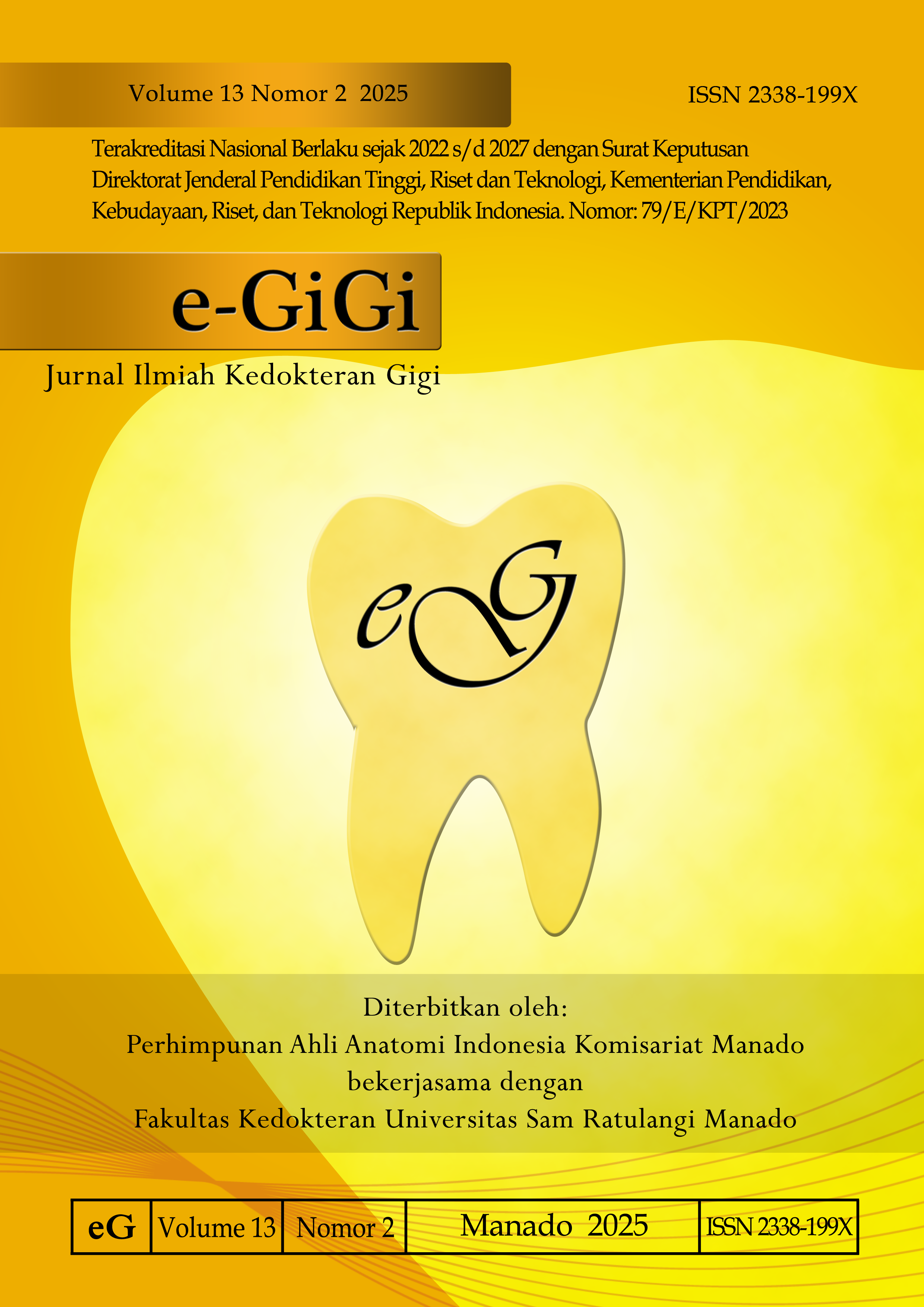Efektivitas Dental Health Education Metode Simulasi dan Metode Pemutaran Video terhadap Pengetahuan Kesehatan Gigi dan Mulut Siswa Sekolah Dasar
DOI:
https://doi.org/10.35790/eg.v13i2.60185Abstract
Abstract: Oral and dental health issues remain a predominant global concern, and Indonesia itself still faces a relatively high prevalence of caries among children aged 10-14 years. Poor oral health habits can be a contributing factor to the development of tooth decay in children. Behavioral changes in children can be achieved through increased knowledge. Interventions through Dental Health Education (DHE) using appropriate methods and media can be conducted to enhance children's knowledge of oral and dental health, expecting of subsequently influencing on their behaviors. This study aimed to compare the effectiveness of DHE using simulation and video playback methods in improving the knowledge of oral and dental health among elementary school students. This was a quasi-experimental study with a non-equivalent control group, employing pre-tests and post-tests. The study samples consisted of 60 students of SD Negeri Kalasey (elementary school) Manado as respondents, selected through total sampling. The Wilcoxon test conducted on the simulation and video playback education groups obtained a p-value of 0.00 (p<0.05), indicating an improvement of knowledge for both methods. The Mann-Whitney test showed a p-value of 0.689 (p>0.05), indicating there was no significant difference between the two methods. In conclusion, there is no difference in effectiveness between Dental Health Education using simulation and video playback methods.
Keywords: dental health education; simulation; video playback; knowledge
Abstrak: Kesehatan gigi dan mulut masih merupakan masalah global. Indonesia masih memiliki prevalensi karies yang cukup tinggi pada anak usia 10-14 tahun. Perilaku yang buruk dalam menjaga kesehatan gigi dan mulut dapat menjadi faktor yang berpengaruh terhadap timbulnya karies gigi pada anak. Perubahan perilaku pada anak dapat diperoleh melalui peningkatan pengetahuan. Intervensi melalui pemberian Dental Health Education (DHE) dengan penggunaan metode dan media yang tepat dapat dilakukan untuk meningkatkan pengetahuan kesehatan gigi dan mulut anak, yang diharapkan dapat mengubah perilaku anak. Penelitian ini bertujuan untuk mengetahui perbandingan efektivitas antara DHE metode simulasi dan metode pemutaran video terhadap peningkatan pengetahuan kesehatan gigi dan mulut pada siswa sekolah dasar (SD). Jenis penelitian ialah quasi experimental dengan non-equivalent control group design dan digunakan pre-test dan post-test. Sampel penelitian berjumlah 60 murid SD Negeri Kalasey Manado sebagai responden dengan pengambilan sampel menggunakan total sampling. Hasil uji Wilcoxon terhadap kelompok penyuluhan metode simulasi dan metode pemutaran video menunjukkan nilai p=0,00 (p<0,05) yang berarti pada kedua metode terdapat perbedaan bermakna sebelum dan setelah diberikan perlakuan. Hasil uji Mann-Whitney menunjukkan nilai p=0,689 (p>0,05), yang berarti tidak terdapat perbedaan bermakna antara kedua metode. Simpulan penelitian ini ialah tidak terdapat perbedaan bermakna pada efektivitas antara Dental Health Education metode simulasi dan metode pemutaran video.
Kata kunci: dental health education; simulasi; pemutaran video; pengetahuan
References
Hadju L, Asriani. Pengaruh penyuluhan melalui media leaflet terhadap peningkatan pengetahuan kesehatan gigi dan mulut pada siswa kelas V di SD Negeri 18 Mandonga Kota Kendari. Miracle Journal of Public Health. 2020;3(1):33. Doi: https://doi.org/10.36566/mjph/vol3.iss1/136
WHO. Global oral health status report: Towards universal health coverage for oral health by 2030. Geneva: World Health Organization; 2022.
Balitbangkes RI. Laporan Riskesdas 2018 Nasional. Jakarta: Lemb. Balitbangkes; 2018.
Puspitaningtiyas R, Leman MA, Juliatri. Perbandingan efektivitas dental health education metode ceramah dan metode permainan simulasi terhadap peningkatan pengetahuan kesehatan gigi dan mulut anak. e-GiG. 2017;5(1):68–3. Doi: https://doi.org/10.35790/eg.5.1.2017.15523
Habbu SG, Krishnappa P. Effectiveness of oral health education in children - A systematic review of current evidence (2005-2011). Int Dent J. 2015;65(2):57–64. Doi: https://doi.org/10.1111/idj.12137
Pitoy AD, Wowor VNS, Leman MA. Efektivitas dental health education menggunakan media audio visual dalam meningkatkan pengetahuan siswa sekolah dasar. e-GiGi. 2021;9(2):243. Doi: https://doi.org/ 10.35790/eg.v9i2.34903
Reca R, Mardhiah A, Nuraskin CA. Pelaksanaan dental health education (dhe) dalam meningkatkan status kebersihan gigi dan mulut pada murid SDN 33 Kota Banda Aceh. J Sago Gizi dan Kesehat. 2020;1(2):128. Doi: https://doi.org/10.30867/gikes.v1i2.404
Mahendra D, Jaya IMM, Lumban AMR. Buku Ajar Promosi Kesehatan. Jakarta: Universitas Kristen Indonesia; 2019. p. 1 – 7.
Putriani G. Peningkatan upaya pembelajaran bina diri menggosok gigi melalui media video animasi pada anak tunagrahita kategori sedang kelas IV SDLB di SLB Negeri Pembina Yogyakarta [Skripsi]. Yogyakarta: Universitas Negeri Yogyakarta; 2016.
Nahak MV. Efektivitas penyuluhan dengan metode demonstrasi dan simulasi menyikat gigi terhadap penurunan OHI-S pada siswa-siswi kelas V SD Inpres Liliba Kupang [Karya Tulis Ilmiah]. Kupang: Politeknik Kesehatan Kemenkes Kupang; 2019.
Sulastri, Ridwan M, Thaha SSRM. Pengaruh penyuluhan kesehatan menggunakan video dalam pemeriksaan payudara sendiri (Sadari) terhadap perubahan pengetahuan dan sikap remaja putri di SMAN 9 Balikpapan tahun 2012. Jurnal Ilmu Kesehatan Immanuel. 2012;10(10):1-12. Doi: https://doi.org/ 10.36051/jiki.v17i1.205
Astuti E. Studi komparasi promosi kesehatan antara simulasi dan penayangan video terhadap perilaku personal hygiene anak usia sekolah di SD N Kaliduren Moyudan Sleman Yogyakarta [Naskah Publikasi]. Yogyakarta: STIK Aisyiyah; 2012.
Downloads
Published
How to Cite
Issue
Section
License
Copyright (c) 2025 Jordan A. C. Siwi, Ni Wayan Mariati, Vonny N. S. Wowor

This work is licensed under a Creative Commons Attribution-NonCommercial 4.0 International License.
COPYRIGHT
Authors who publish with this journal agree to the following terms:
Authors hold their copyright and grant this journal the privilege of first publication, with the work simultaneously licensed under a Creative Commons Attribution License that permits others to impart the work with an acknowledgment of the work's origin and initial publication by this journal.
Authors can enter into separate or additional contractual arrangements for the non-exclusive distribution of the journal's published version of the work (for example, post it to an institutional repository or publish it in a book), with an acknowledgment of its underlying publication in this journal.
Authors are permitted and encouraged to post their work online (for example, in institutional repositories or on their website) as it can lead to productive exchanges, as well as earlier and greater citation of the published work (See The Effect of Open Access).






